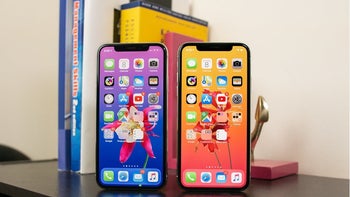Will Apple kill the notch in 2020? Next year's iPhones may all be redesigned around OLED displays

Apple's iPhones will undertake a redesign next year, tip industry sources today, and they also claim that the team from Cupertino will ditch LCD displays for a complete switch to OLEDs in 2020.
The display diagonals are expected to stay 5.8-inch, 6.06-inch, and 6.4-inch but the flexible OLEDs will be weaved into a new external look. That's in contrast to this year when the changes are mainly expected to be under the hood, the iPhone XR successor is expected to still carry an LCD screen, and the only real design change might stem from new camera configurations.
The tip about a redesigned iPhone 2020 jibes with the rumor that Apple may ditch the notch for something else completely then, which would be rather ironic, considering how many other manufacturers started chasing the design with top bezel protrusion.
Apple will reportedly have diversified its OLED display suppliers by next year, and, while it is planning to use such panels in all three 2020 iPhones, it has also given proof of interest for the above-mentioned display diagonals to three companies.
First in line is, of course, Samsung, but LG Display and the Chinese from BOE will also be making panels for next year's iPhones, it appears, to the chagrin of JDI and LG that supply the current iPhone XR panel. The insiders also claim that the more expensive 5.8" and 6.4" iPhones next year will have the touch functionality integrated into the panel itself, while the 6.1" model will sport an OLED with an extra touch layer which is cheaper to produce and thus easier to source in mass quantities.
Apple had initial troubles producing the Face ID modules for the iPhone X due to the precision needed for certain parts, but now all of this is behind it, and there have even been reports that its suppliers have managed to shrink the kit further.
In addition, Apple has already patented several ways it might go about without a notch. One includes holes in the display itself, and another a matrix underneath that will let the sensor emitters pass between the pixels themselves. If Finisar and other TrueDepth camera sensor suppliers have managed to make the whole setup even smaller, it would explain why Apple may have decided to improve the screen-to-body ratio further, as the current state of its "all-screen" efforts clashes with its minimalist design heritage pretty obviously.
Next year, the notch may shrink to even out with the frame, and we could even see an in-display finger scanner added, making the 2020 iPhone the ultimate "all-screen" biometry machine. As for the switch from LCD to OLED for the iPhone XR, the Wall Street Journal recently reported that Japan Display has already set a contingency plan for the times it will lose Apple as a big customer. It has even lined up new investors to scoop up some stake in its production, hoping to weather the storm better when Apple ceases ordering LCD screens from it.
If you remember, the LCD iPhone XR indeed arrived much later than the OLED models. The culprit behind this delay was yield issues for the "Liquid Retina" display, though the analysts differed in the exact reasoning. At first, the culprit was pegged as light bleeding from the LCD display around the notch, yet the supply chain sources in the later report said there was another bottleneck.
The faux 3D Touch that Apple's Phil Schiller said works just like the real thing during the XR's keynote, may had proved problematic to create en masse as well, although the real thing has apparently been incorporated on the more expensive OLED iPhones without problems already. At this point, it's anyone's guess what were the real reasons behind the XR's delay, but it is obviously easier to implement any notches or piercings on a flexible OLED, and that's exactly what the XR may carry next year, too.













Things that are NOT allowed: